Analysis of Spatial and Temporal Characteristics of Citizens’ Mobility Based on E-Bike GPS Trajectory Data in Tengzhou City, China
Abstract
:1. Introduction
2. Literature Review
3. Materials and Methods
3.1. Study Area and Data Source
3.2. Data Processing and Cleansing
- (1)
- Determine data range: delete trajectory points that are located out of the e-bike service area.
- (2)
- Identify device abnormality: if the sample includes a greater-than-10-min time gap between two points, it is regarded as device abnormality. These two points are thus separated to be independent from each other and labeled as a destination and an origin point, respectively.
- (3)
- Cleanse special and invalid values: After calculating the average speed between adjacent points (Euclidean distance between points divided by time intervals), there are several possible scenarios that require sample cleansing.
- a)
- Cases of e-bike relocation using high-speed cars: for all continued interval(s) with speed > 35 km/h, abandon the interval(s) and redefine O–D pairs. Contrary to Li et al., 2019 research [24], to avoid the appearance of apparent O–D path discontinuity, this study set the filtering speed to 35 km/h instead of 20 km/h (government speed limit). This can also provide insight into some behaviors and phenomena that violate traffic rules.
- b)
- Cases of traffic light and unused bikes: for independent intervals with speeds < 4 km/h, if the time gap is less than 2 min, we suspect that users are waiting for traffic lights, with no alteration to the data sample. If the time gap is longer than 2 min, eliminate the sample interval (device abnormality). For continued intervals with speed < 4 km/h, delete all intervals (we speculate that bicycles are unused during this period).
- c)
- Cases of positioning floating: after steps a and b, cleanse all the O–D pairs that have a sample distance less than 50 m.
3.3. Methods and Models
4. Results
4.1. Overall Travel Pattern
4.2. Temporal Mobility Patterns
4.2.1. Monthly Mobility Characterization and Its Relationships between Influencing Factors
4.2.2. Daily Mobility Characterization
4.2.3. Temporal Characterization in Special Weather
4.2.4. Hourly Temporal Characterization
4.3. Spatial Travel Patterns
4.3.1. Travel Characterization Based on Kernel Density Analysis
4.3.2. Identification of Geographic Hotspots
4.3.3. Spillover Commuting
5. Conclusions and Suggestions
Author Contributions
Funding
Conflicts of Interest
References
- Bullock, C.; Brereton, F.; Bailey, S. The economic contribution of public bike-share to the sustainability and efficient functioning of cities. Sustain. Cities Soc. 2017, 28, 76–87. [Google Scholar] [CrossRef]
- Yao, H.; Tang, X.; Wei, H.; Zheng, G.; Yu, Y.; Li, Z. Modeling Spatial and Temporal Dynamics for Traffic Prediction. arXiv 2018, arXiv:1803.01254. [Google Scholar]
- Kabra, A.; Belavina, E.; Girotra, K. Bike-Share Systems: Accessibility and Availability. In Chicago Booth Research Paper; The University of Chicago Booth School of Business: Chicago, IL, USA, 2018. [Google Scholar]
- Lohry, G.F.; Yiu, A. Bikeshare in China as a public service: Comparing government-run and public-private partnership operation models. Nat. Resour. Forum 2015, 39, 41–52. [Google Scholar] [CrossRef]
- Du, M.Y.; Cheng, L. Better Understanding the Characteristics and Influential Factors of Different Travel Patterns in Free-Floating Bike Sharing: Evidence from Nanjing, China. Sustainability 2018, 10, 1244. [Google Scholar] [CrossRef]
- Liu, M.; Xu, X.F. Dockless Bike-sharing Reallocation based on Data Analysis: Solving Complex Problem with Simple Method. In Proceedings of the 2018 IEEE Third International Conference on Data Science in Cyberspace (DSC), Guangzhou, China, 18–21 June 2018. [Google Scholar]
- Zhao, Y.; Dai, L.; Peng, L.; Song, Y.; Zhou, Z. Analysis of Spatial distribution of China’s station-free bike-sharing by Clustering Algorithms. In Proceedings of the 2019 4th International Conference on Mathematics and Artificial Intelligence, Chengdu, China, 12–15 April 2019; pp. 15–19. [Google Scholar]
- Siła-Nowicka, K.; Vandrol, J.; Oshan, T.; Long, J.A.; Demšar, U.; Fotheringham, A.S. Analysis of human mobility patterns from GPS trajectories and contextual information. Int. J. Geogr. Inf. Sci. 2015, 30, 881–906. [Google Scholar] [CrossRef]
- Cools, M.; Moons, E.; Wets, G. Assessing the impact of weather on traffic intensity. Weather Clim. Soc. 2010, 2, 60–68. [Google Scholar] [CrossRef]
- Cools, M.; Moons, E.; Creemers, L.; Wets, G. Changes in travel behavior in response to weather conditions: Do type of weather and trip purpose matter? Transp. Res. Rec. 2010, 2157, 22–28. [Google Scholar] [CrossRef]
- Cools, M.; Creemers, L. The dual role of weather forecasts on changes in activity-travel behavior. J. Transp. Geogr. 2013, 28, 167–175. [Google Scholar] [CrossRef]
- Liu, C. Understanding the Impacts of Weather and Climate Change on Travel Behaviour. Ph.D. Thesis, KTH Royal Institute of Technology, Stockholm, Sweden, 2016. [Google Scholar]
- Luo, X.; Dong, L.; Dou, Y.; Zhang, N.; Ren, J.; Li, Y.; Sun, L.; Yao, S. Analysis on spatial-temporal features of taxis’ emissions from big data informed travel patterns: A case of Shanghai, China. J. Clean. Prod. 2017, 142, 926–935. [Google Scholar] [CrossRef]
- Yang, Y.; Comber, A.; Heppenstall, A.; Turner, A. Exploring Spatiotemporal Features of Station-Free Bike Sharing Trips: Case Study of Shenzhen. In Proceedings of the GeoComputation ’17, Leeds, UK, 3–7 September 2017. [Google Scholar]
- Sun, D.H.; Wang, B. Research on the Characteristics of Bike Sharing Based on Geographic Information Data. Softw. Guide 2019, 18, 138–142. [Google Scholar]
- Hao, J.; Zhu, J.; Zhong, R. On Space-Time Characteristics of Shared Bikes in Nanjing Based on Big Data. J. Southwest China Norm. Univ. (Nat. Sci. Ed.) 2018, 43, 66–73. [Google Scholar]
- Wei, Z.; Mo, H.; Liu, Y. Spatiotemporal characteristics of bike-sharing: An empirical study of Tianhe District, Guangzhou. Sci. Guid. 2018, 30, 71–80. [Google Scholar]
- Wong, J.T.; Cheng, C.Y. Exploring Activity Patterns of The Taipei Public Bikesharing System. J. East. Asia Soc. Transp. Stud. 2015, 11, 1012–1028. [Google Scholar]
- Vogel, P.; Greiser, T.; Mattfeld, D.C. Understanding Bike-Sharing Systems using Data Mining: Exploring Activity Patterns. Procedia Soc. Behav. Sci. 2011, 20, 514–523. [Google Scholar] [CrossRef]
- Munoz-Mendez, F.; Klemmer, K.; Han, K. Community Structures, Interactions and Dynamics in London’s Bicycle Sharing Network. arXiv 2018, arXiv:1804.05584. [Google Scholar]
- Zhou, X.L. Understanding Spatiotemporal Patterns of Biking Behavior by Analyzing Massive Bike Sharing Data in Chicago. PLoS ONE 2015, 10, 1371. [Google Scholar] [CrossRef] [PubMed]
- Kou, Z.; Cai, H. Understanding bike sharing travel patterns: An analysis of trip data from eight cities. Phys. A Stat. Mech. Appl. 2019, 515, 785–797. [Google Scholar] [CrossRef]
- Faghih-Imani, A.; Eluru, N. Incorporating the impact of spatio-temporal interactions on bicycle sharing system demand: A case study of New York CitiBike system. J. Transp. Geogr. 2016, 54, 218–227. [Google Scholar] [CrossRef]
- Li, C.; Dai, Z.; Peng, W.; Shen, J. Green Travel Mode: Trajectory Data Cleansing Method for Shared Electric Bicycles. Sustainability 2019, 11, 1429. [Google Scholar] [CrossRef]
- Ma, K.R.; Banister, D. Excess Commuting: A Critical Review. Transp. Rev. 2006, 26, 749–767. [Google Scholar] [CrossRef]
- Shen, R.; Xie, H.; Liu, Y. Can Popularity of Rail Transit and Bike-sharing Improve Air Quality? A Case Study on Wuhan City. J. China Univ. Geosci. (Soc. Sci. Ed.) 2018, 18, 95–110. [Google Scholar]
- Corcoran, J.; Li, T.; Rohde, D.; Charles-Edwards, E.; Mateo-Babiano, D. Spatio-temporal patterns of a Public Bicycle Sharing Program: The effect of weather and calendar events. J. Transp. Geogr. 2014, 41, 292–305. [Google Scholar] [CrossRef]
- Xie, X.F.; Wang, Z.J. Examining travel patterns and characteristics in a bikesharing network and implications for data-driven decision supports: Case study in the Washington DC area. J. Transp. Geogr. 2018, 71, 84–102. [Google Scholar] [CrossRef]
- Bao, J.; Xu, C.; Liu, P.; Wang, W. Exploring Bikesharing Travel Patterns and Trip Purposes Using Smart Card Data and Online Point of Interests. Netw. Spat. Econ. 2017, 17, 1231–1253. [Google Scholar] [CrossRef]
- Jensen, P.; Rouquier, J.B.; Ovtracht, N.; Robardet, C. Characterizing the speed and paths of shared bicycle use in Lyon. Transp. Res. Part D Transp. Environ. 2010, 15, 522–524. [Google Scholar] [CrossRef]
- Oates, G.R.; Hamby, B.W.; Bae, S.; Norena, M.C.; Hart, H.O.; Fouad, M.N. Bikeshare Use in Urban Communities: Individual and Neighborhood Factors. Ethn. Dis. 2017, 27, 303–312. [Google Scholar] [CrossRef] [PubMed]
- Zhou, J.; Murphy, E.; Long, Y. Commuting efficiency in the Beijing metropolitan area: An exploration combining smartcard and travel survey data. J. Transp. Geogr. 2014, 41, 175–183. [Google Scholar] [CrossRef]
- Gimeneznadal, J.I.; Molina, J.A.; Velilla, J. Excess Commuting in the US: Differences between the Self-Employed and Employees; Social Science Electronic Publishing: New York, NY, USA, 2015. [Google Scholar]
- Ashqar, H.I.; Elhenawy, M.; Almannaa, M.H.; Ghanem, A.; Rakha, H.A.; House, L. Modeling Bike Availability in a Bike-Sharing System Using Machine Learning. In Proceedings of the 2017 5th IEEE International Conference on Models and Technologies for Intelligent Transportation System (MT-ITS), Naples, Italy, 26–28 June 2017. [Google Scholar]
- Xu, C.; Ji, J.; Liu, P. The station-free sharing bike demand forecasting with a deep learning approach and large-scale datasets. Transp. Res. Part C Emerg. Technol. 2018, 95, 47–60. [Google Scholar] [CrossRef]
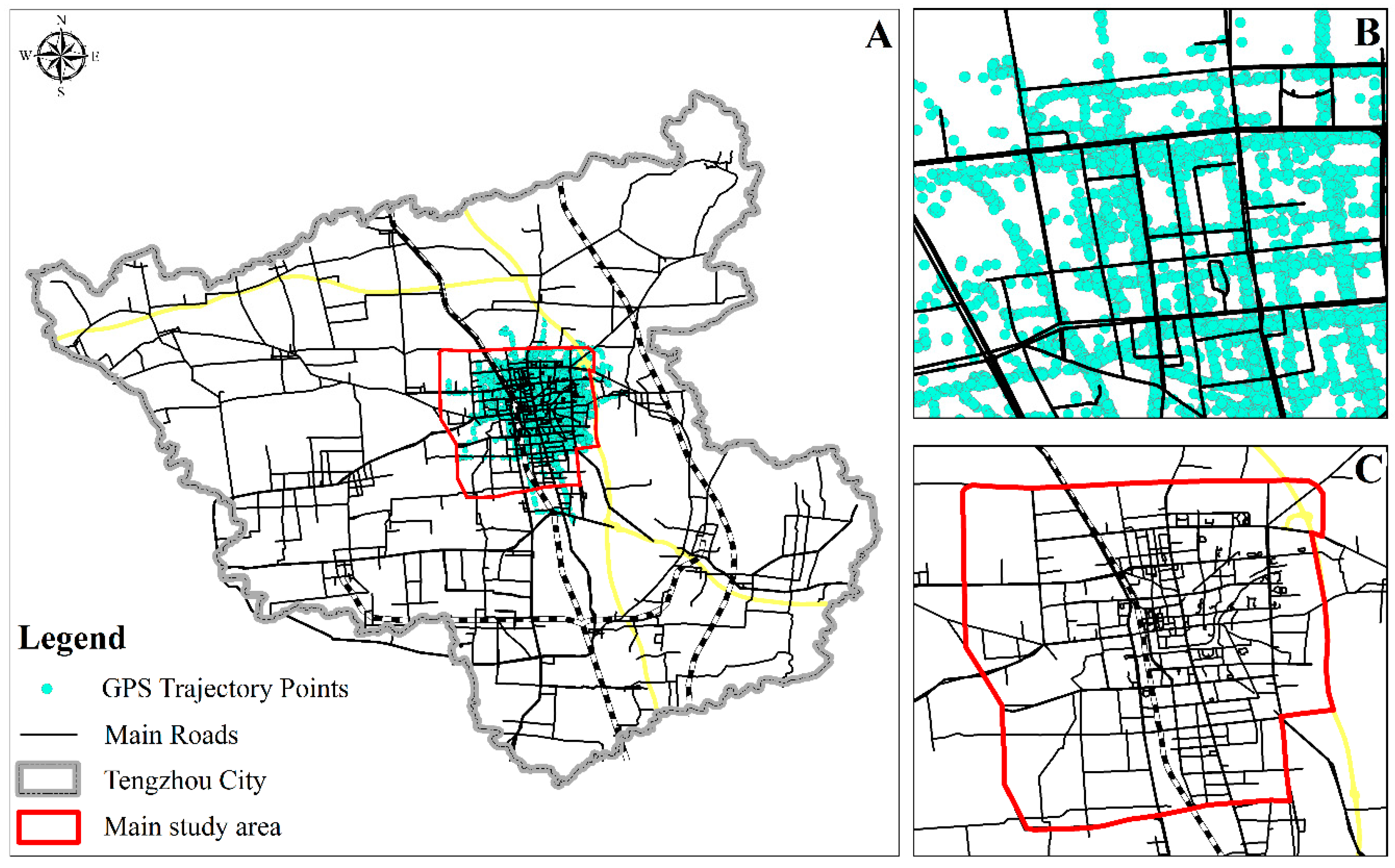
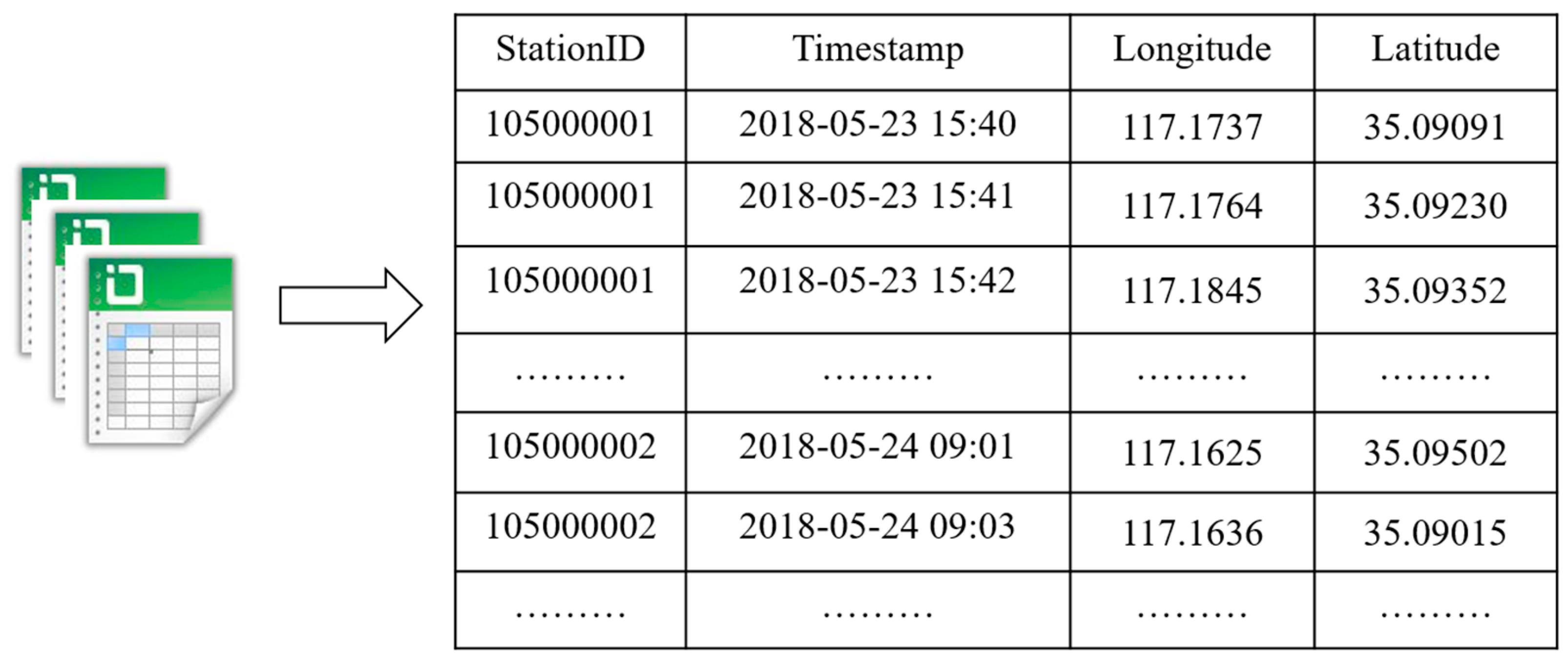
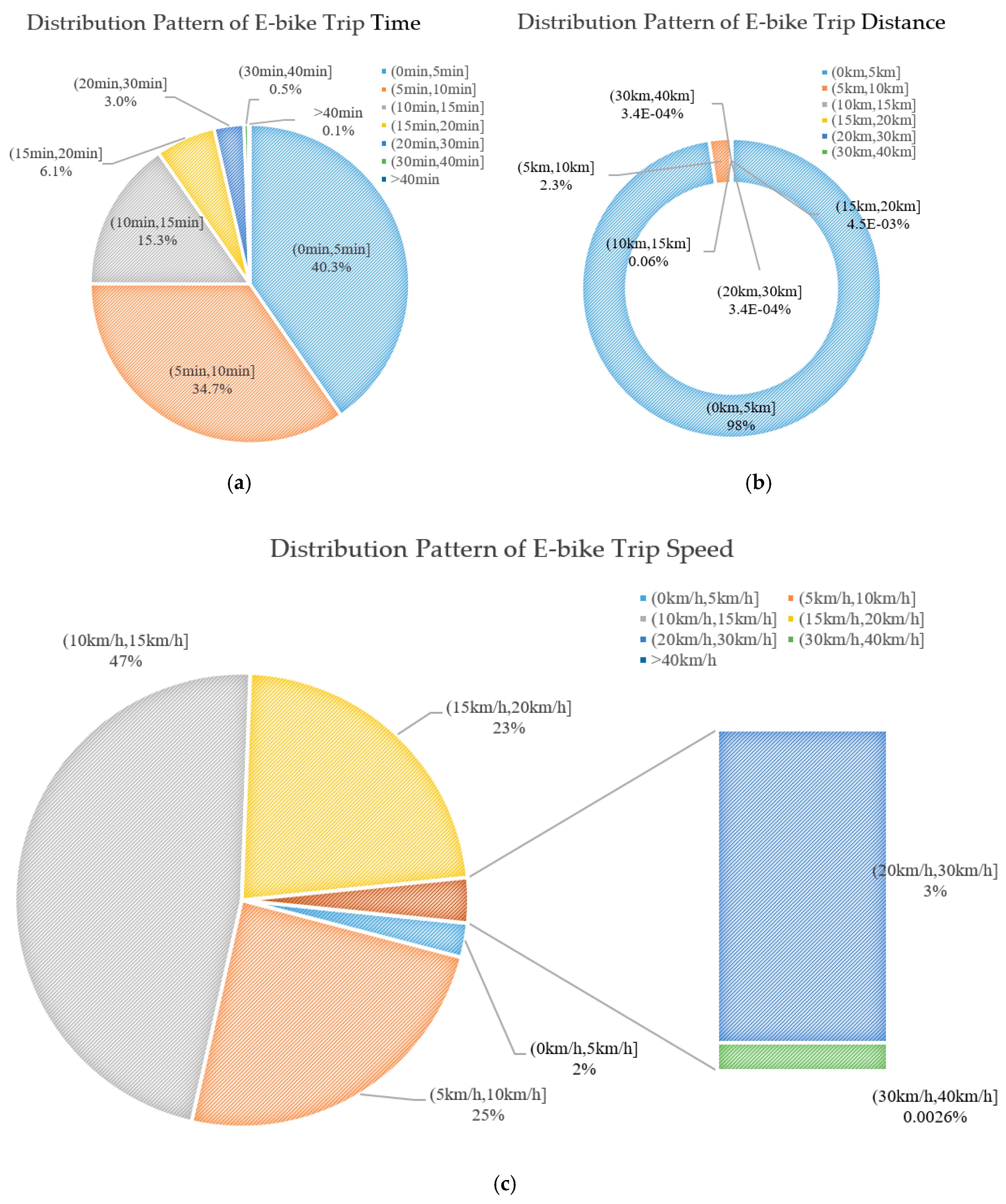

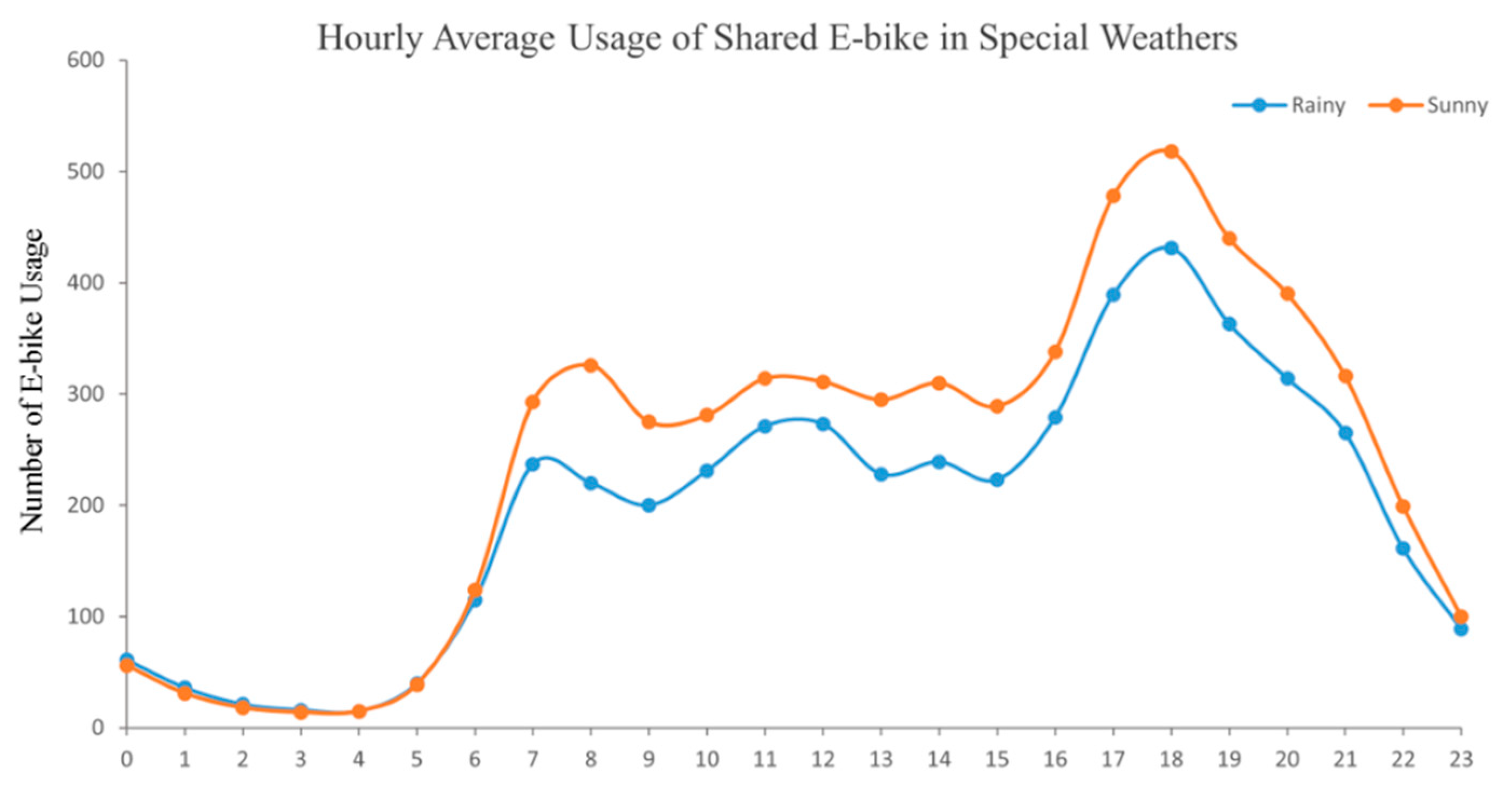
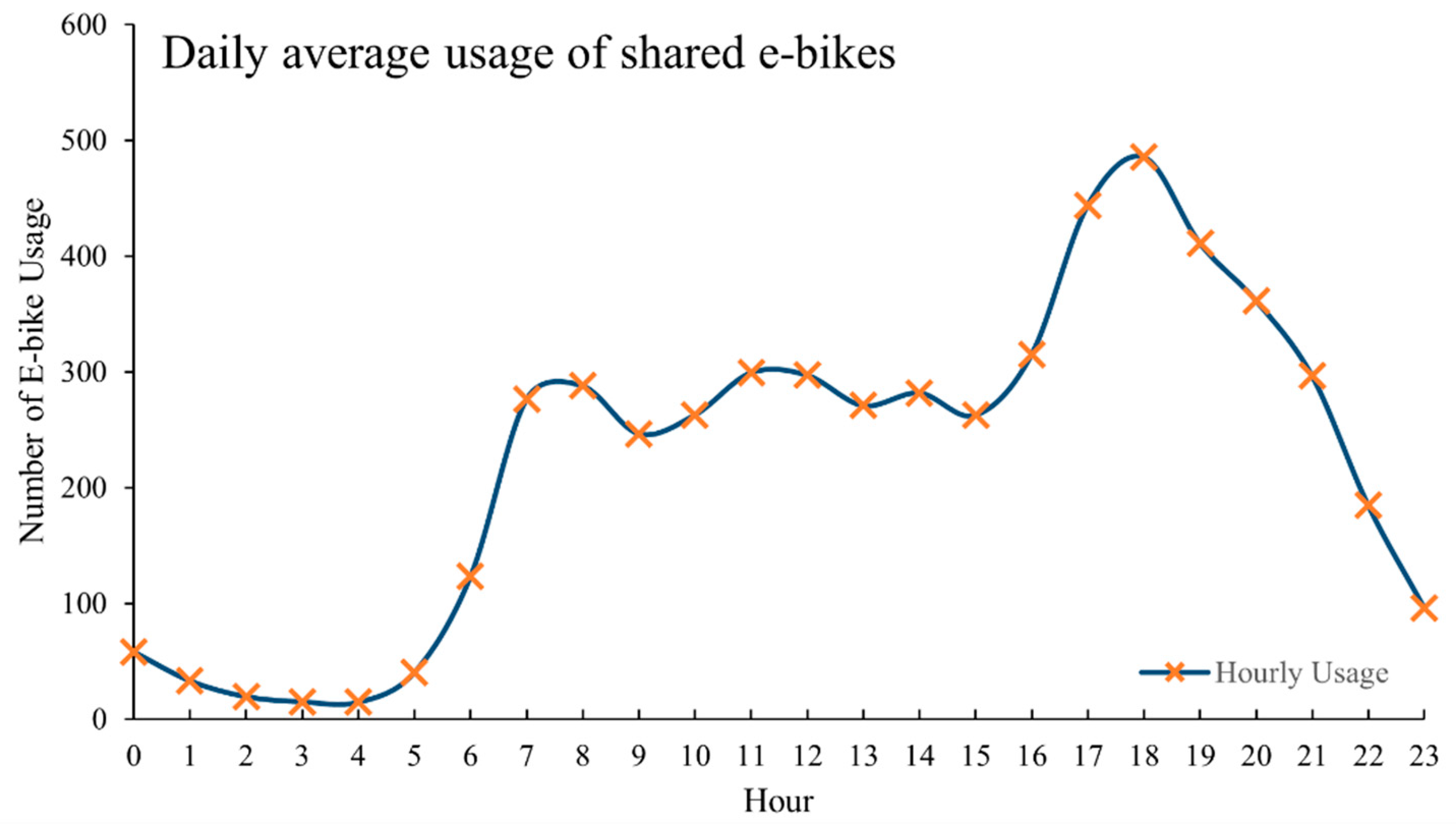
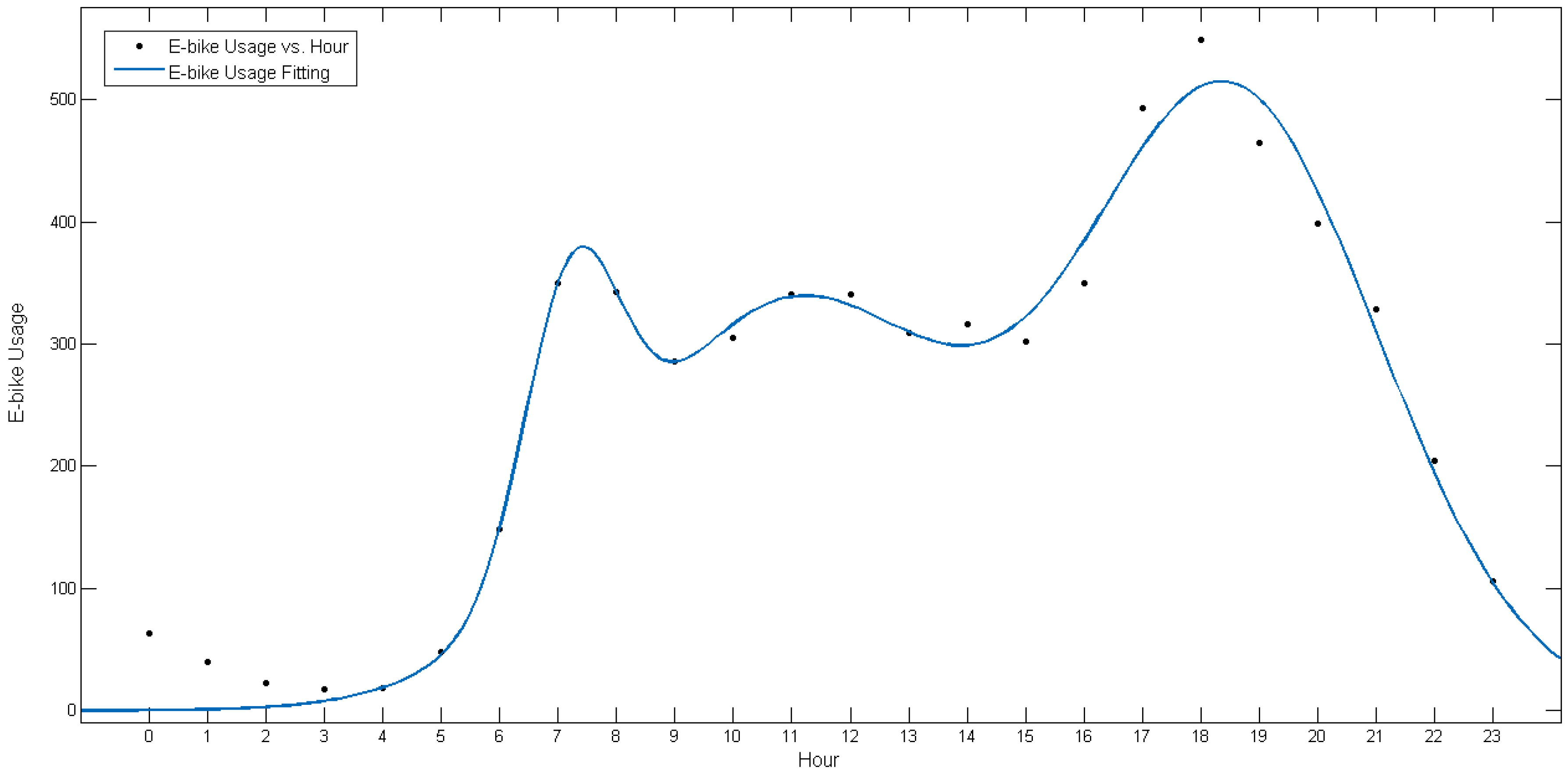
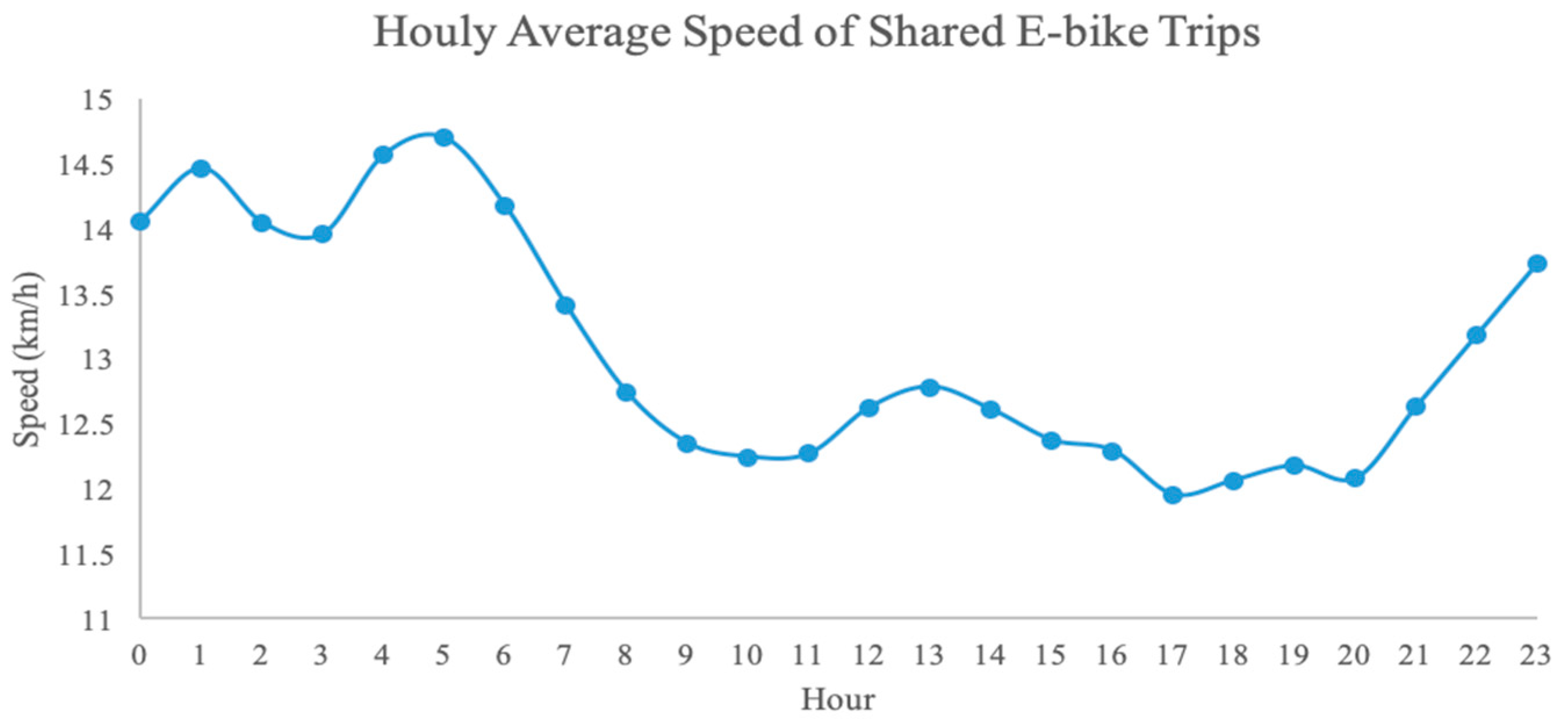
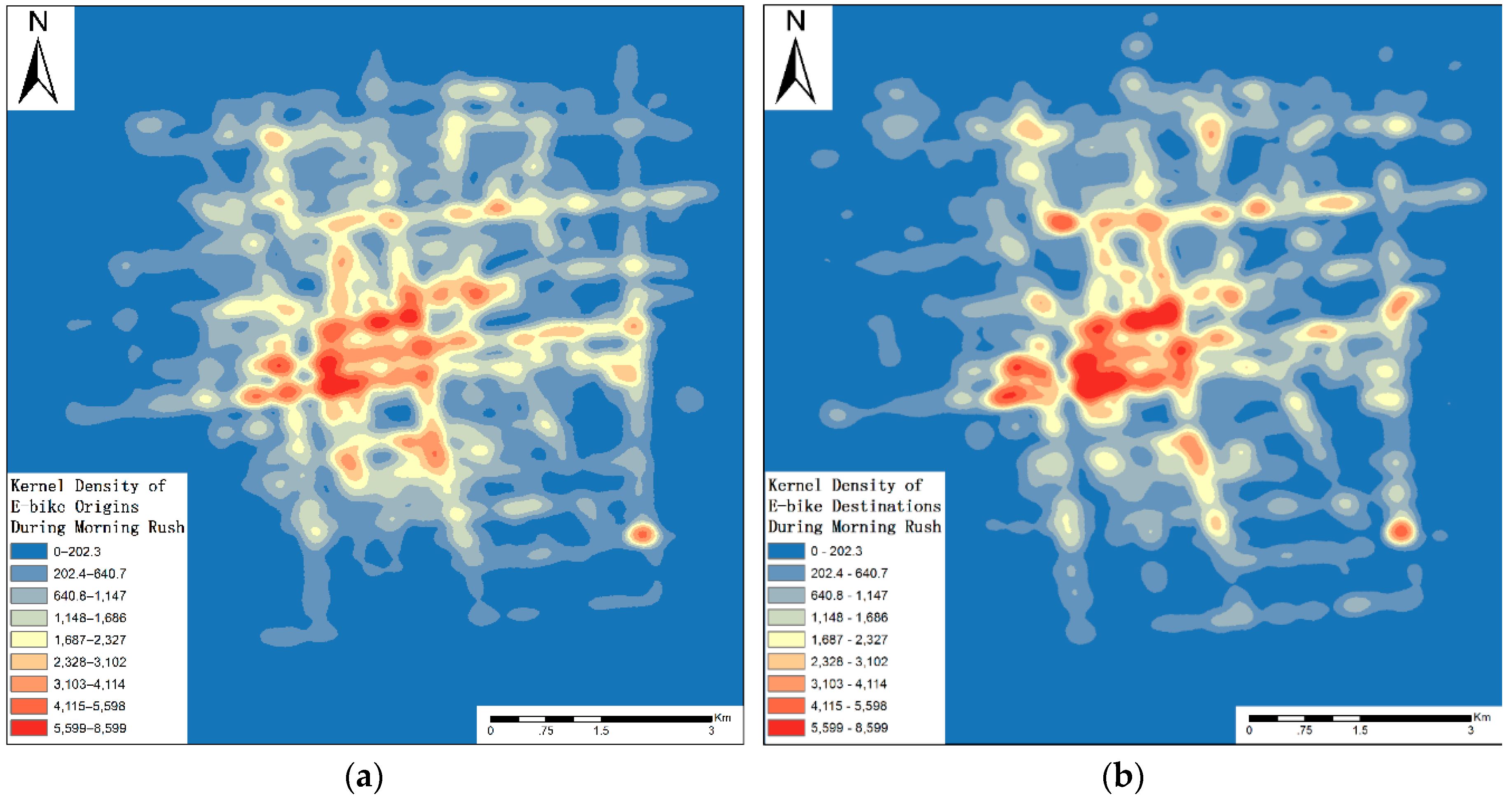
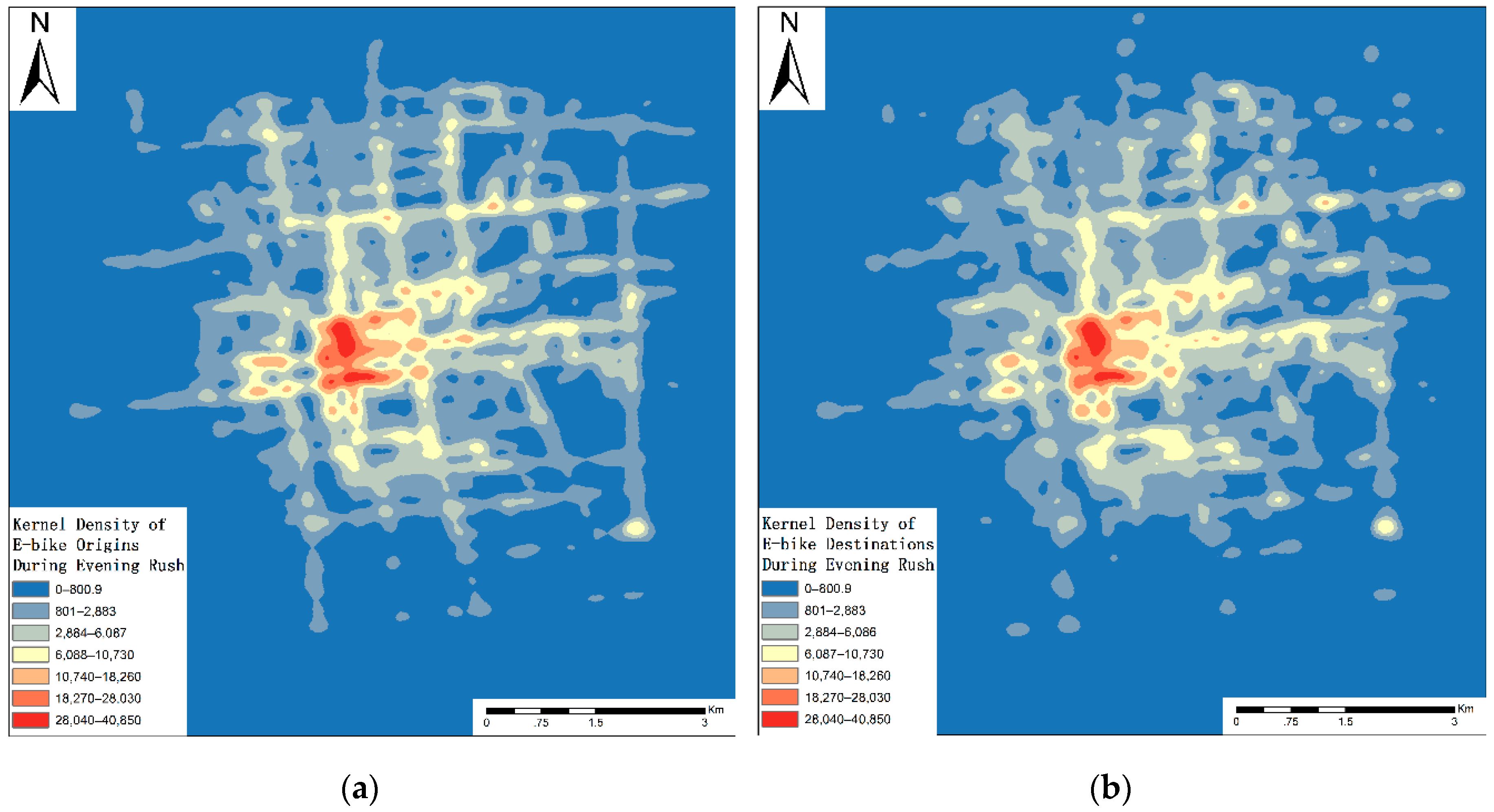
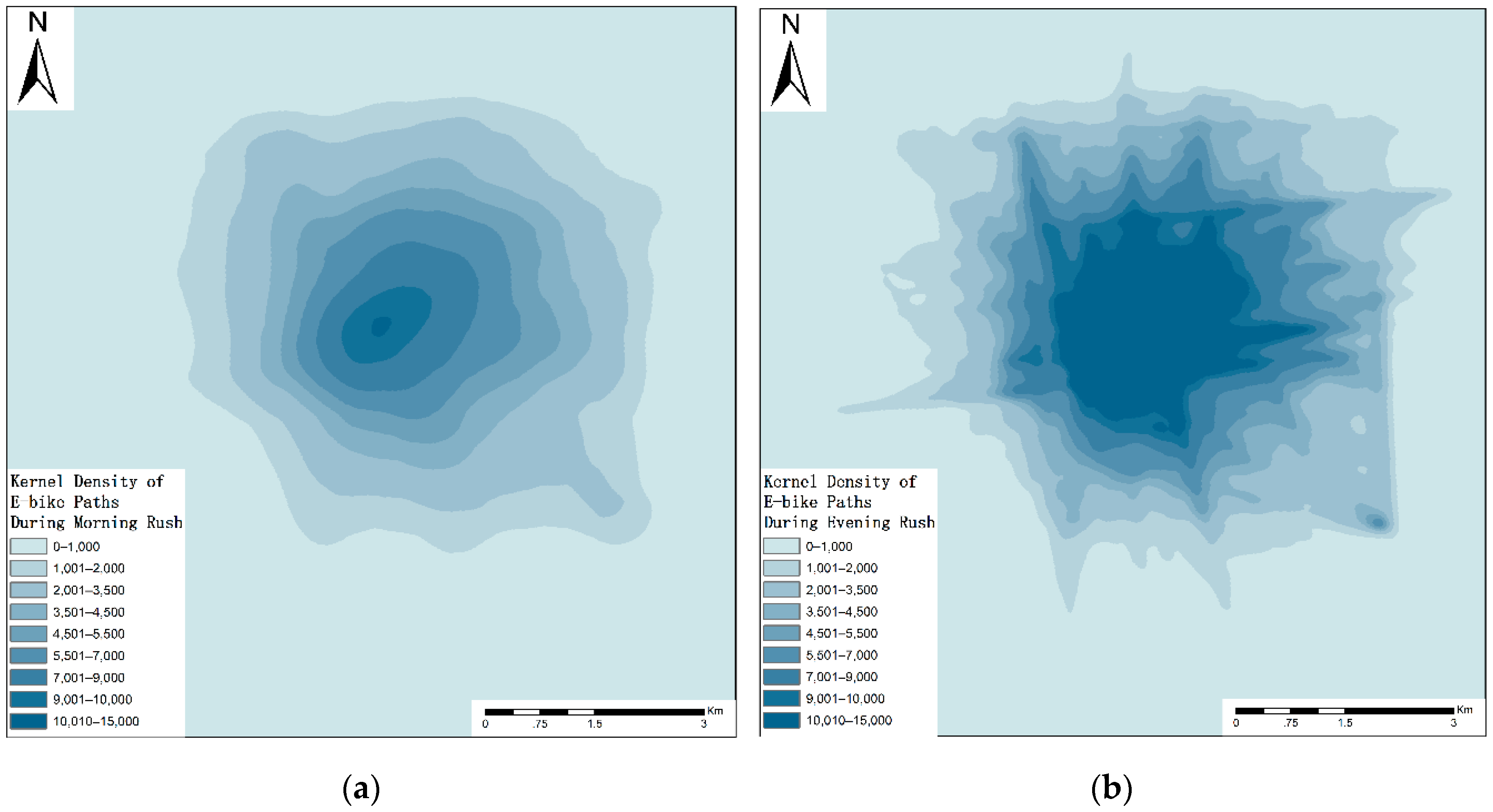
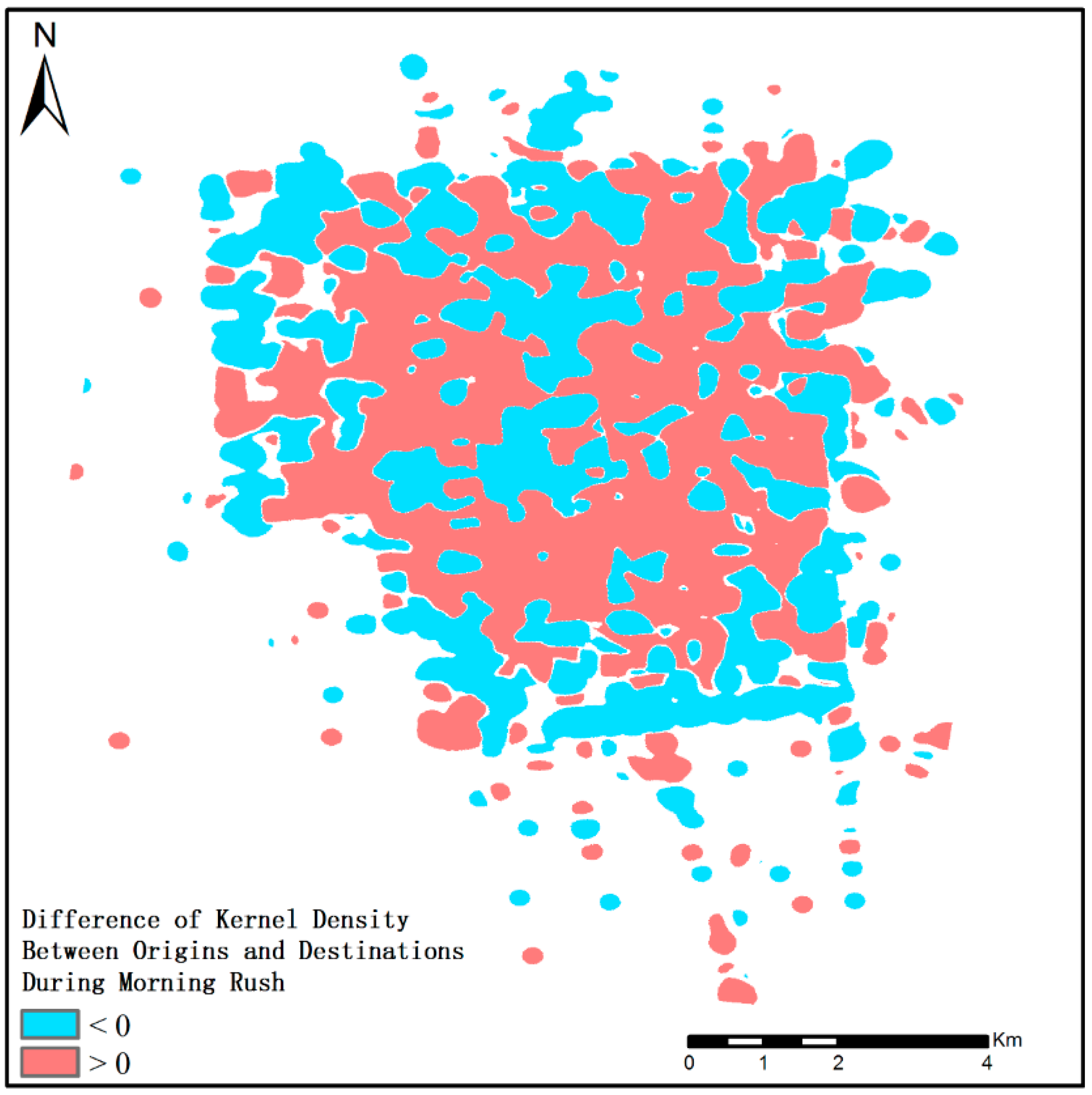
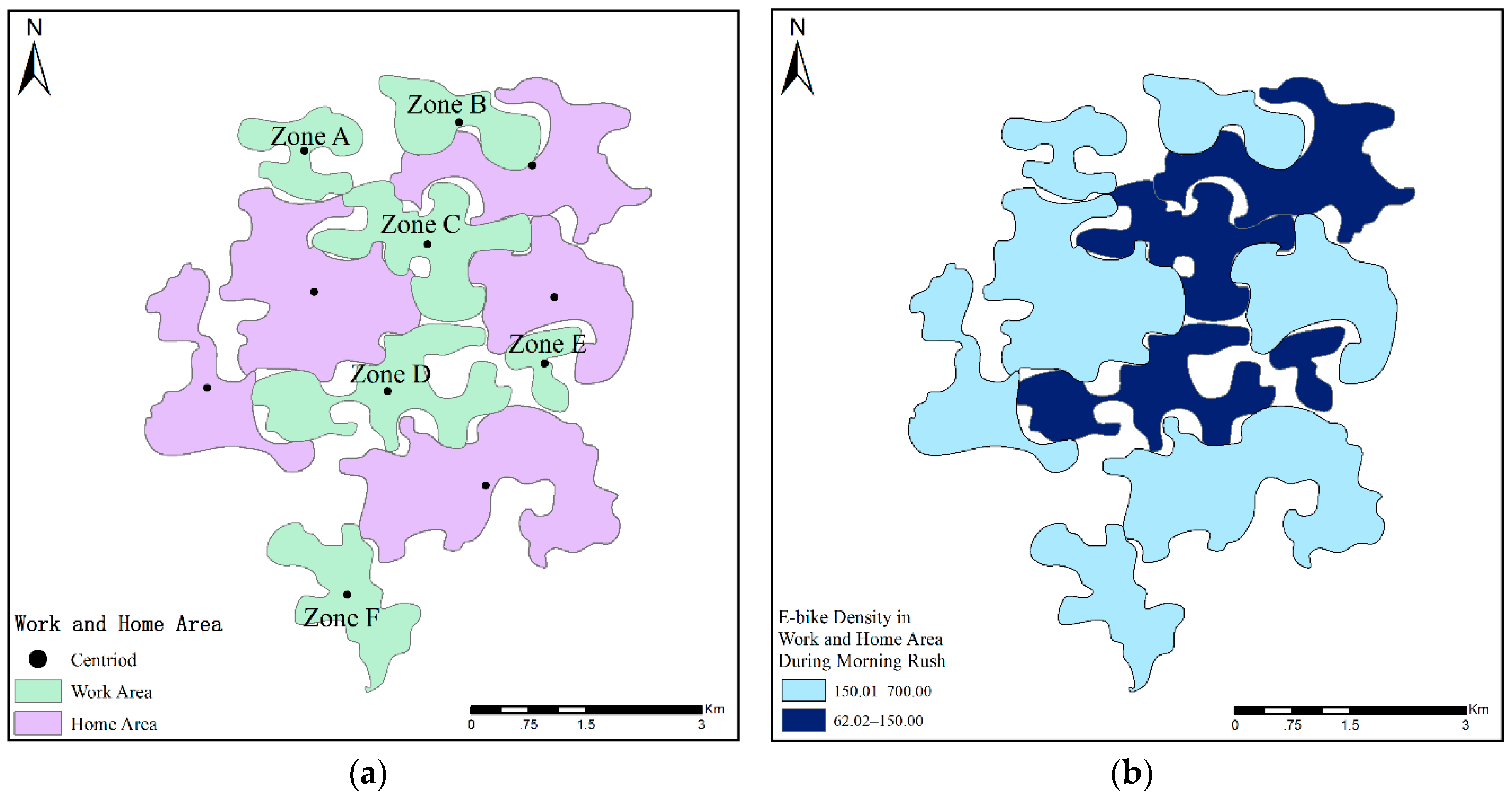
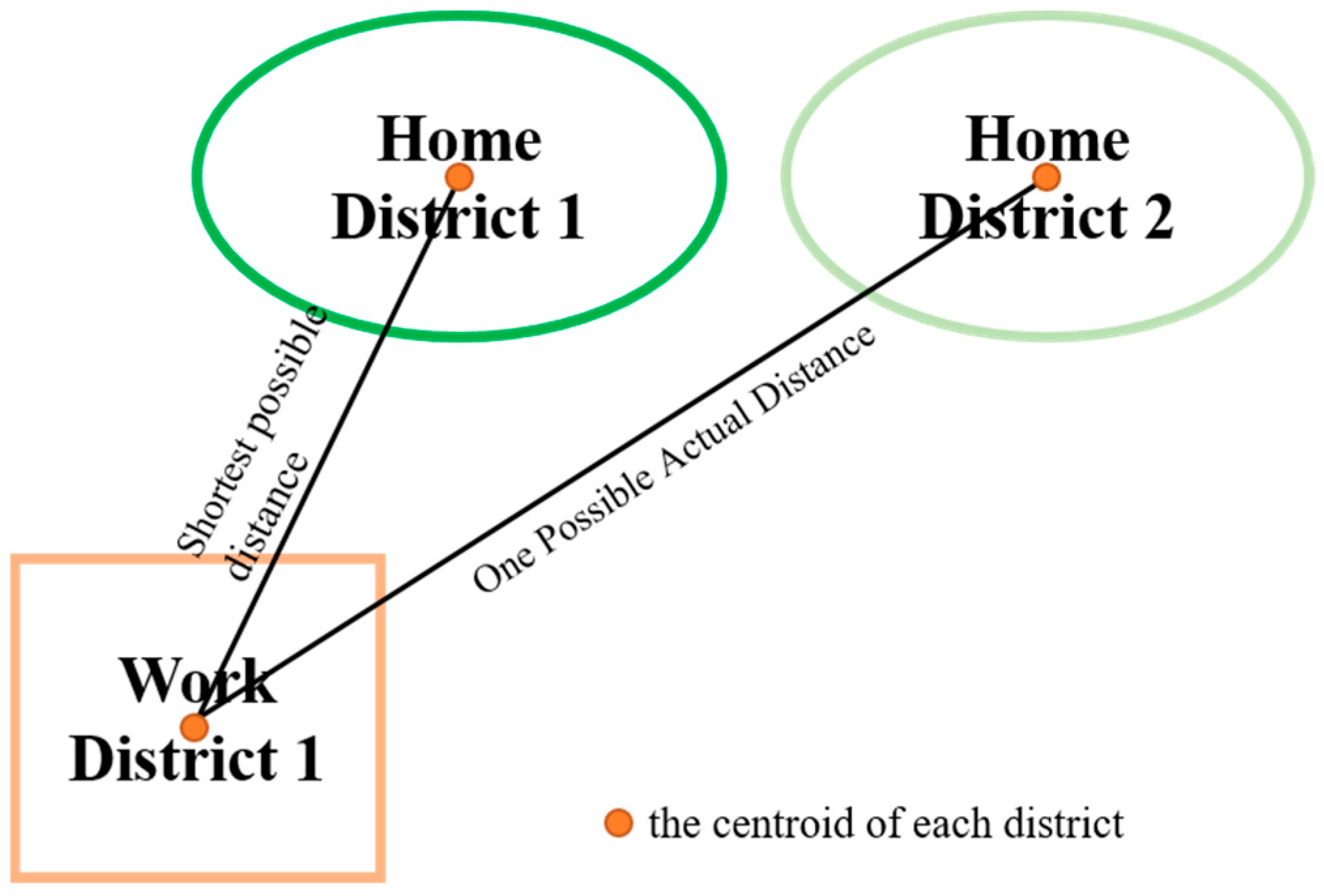
| Month | Average Temperature | Correlation with Temperature | AQI | Correlation with AQI |
|---|---|---|---|---|
| May | 21.7 °C | 0.5633 | 82.5 | 0.71833 |
| June | 26.7 °C | 0.096499 | 88.6 | 0.257916 |
| July | 28.2 °C | −0.11422 | 50.8 | −0.26489 |
| Total | −0.063 | −0.44367 |
© 2019 by the authors. Licensee MDPI, Basel, Switzerland. This article is an open access article distributed under the terms and conditions of the Creative Commons Attribution (CC BY) license (http://creativecommons.org/licenses/by/4.0/).
Share and Cite
Li, Y.; Dai, Z.; Zhu, L.; Liu, X. Analysis of Spatial and Temporal Characteristics of Citizens’ Mobility Based on E-Bike GPS Trajectory Data in Tengzhou City, China. Sustainability 2019, 11, 5003. https://doi.org/10.3390/su11185003
Li Y, Dai Z, Zhu L, Liu X. Analysis of Spatial and Temporal Characteristics of Citizens’ Mobility Based on E-Bike GPS Trajectory Data in Tengzhou City, China. Sustainability. 2019; 11(18):5003. https://doi.org/10.3390/su11185003
Chicago/Turabian StyleLi, Yixiao, Zhaoxin Dai, Lining Zhu, and Xiaoli Liu. 2019. "Analysis of Spatial and Temporal Characteristics of Citizens’ Mobility Based on E-Bike GPS Trajectory Data in Tengzhou City, China" Sustainability 11, no. 18: 5003. https://doi.org/10.3390/su11185003
APA StyleLi, Y., Dai, Z., Zhu, L., & Liu, X. (2019). Analysis of Spatial and Temporal Characteristics of Citizens’ Mobility Based on E-Bike GPS Trajectory Data in Tengzhou City, China. Sustainability, 11(18), 5003. https://doi.org/10.3390/su11185003





